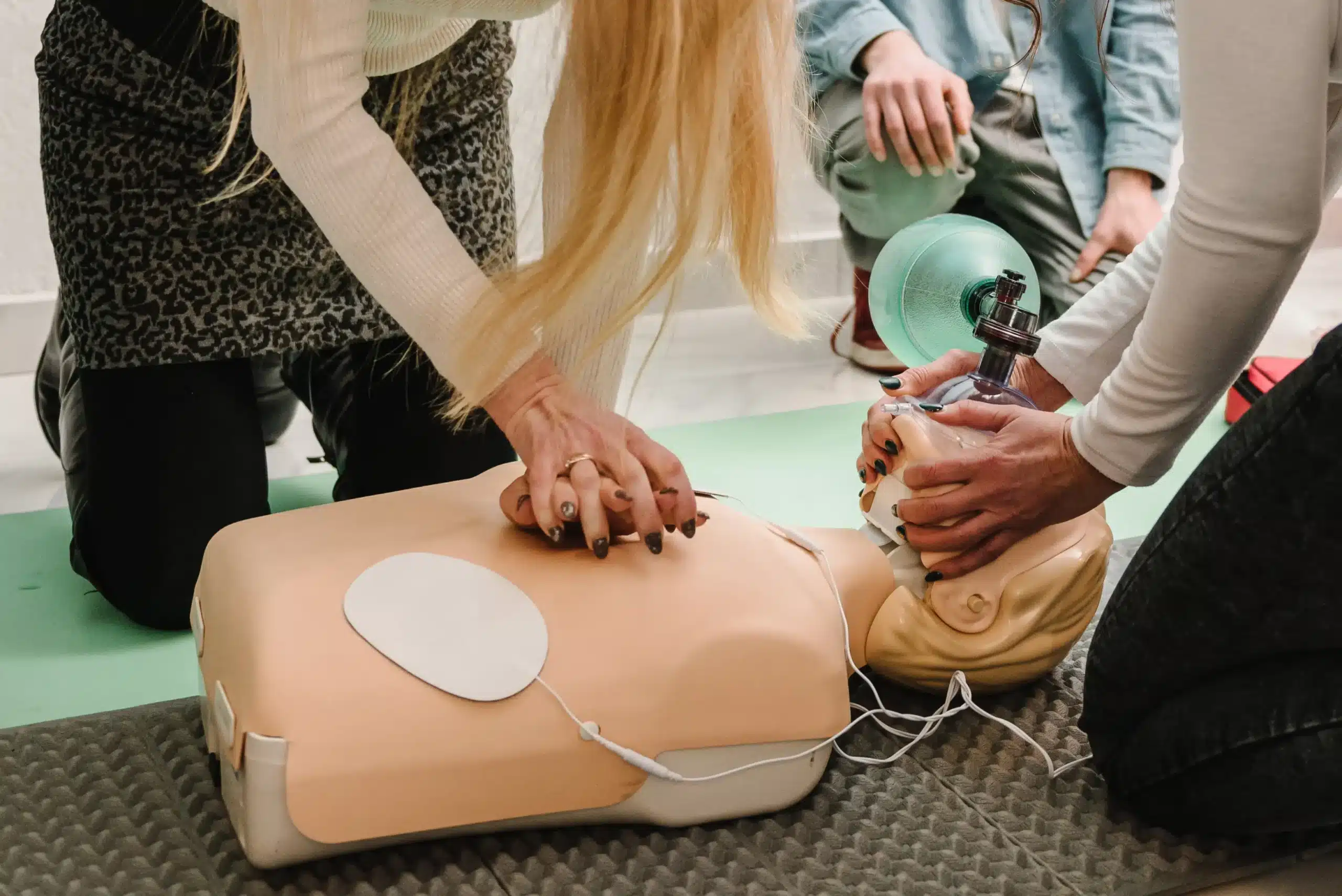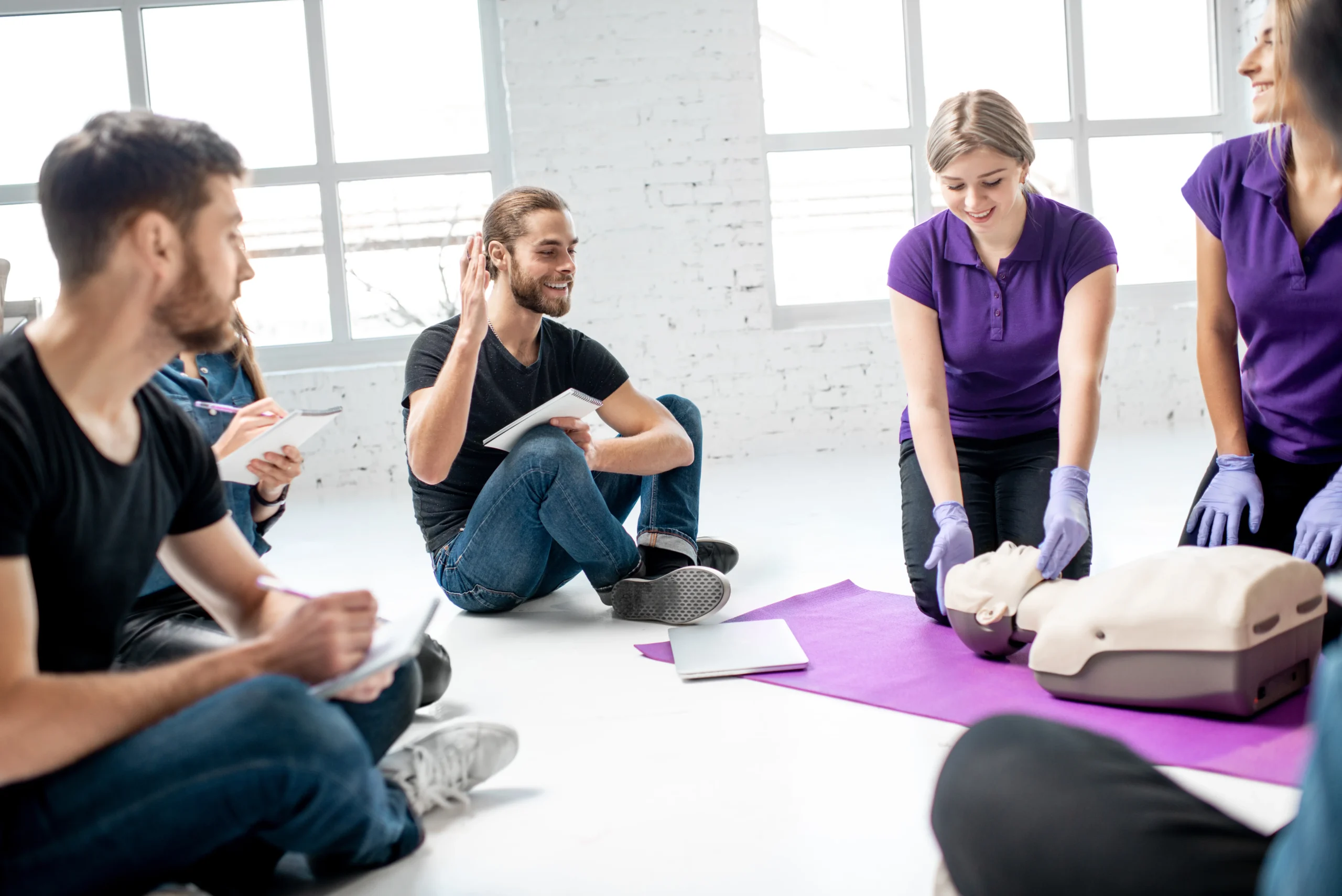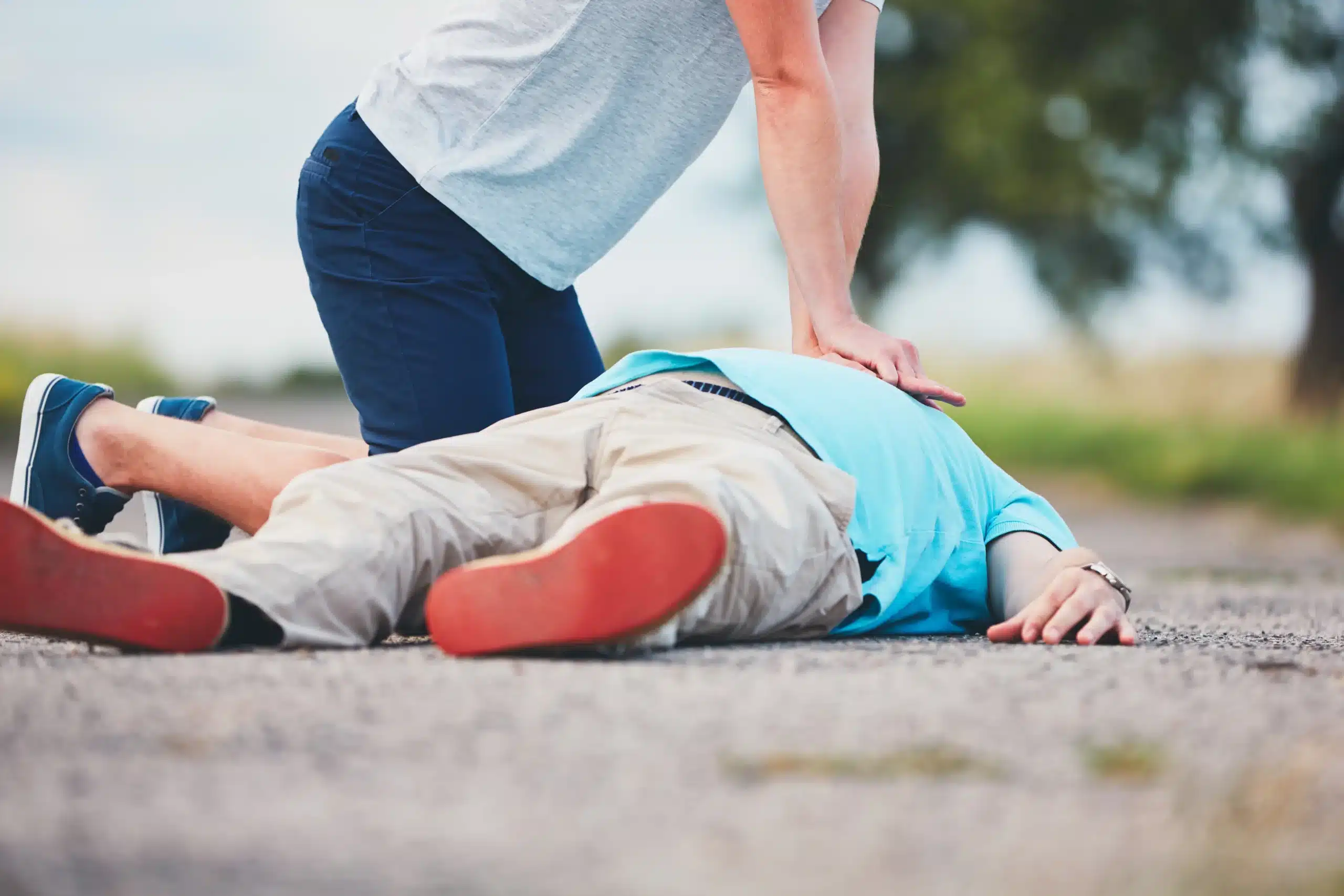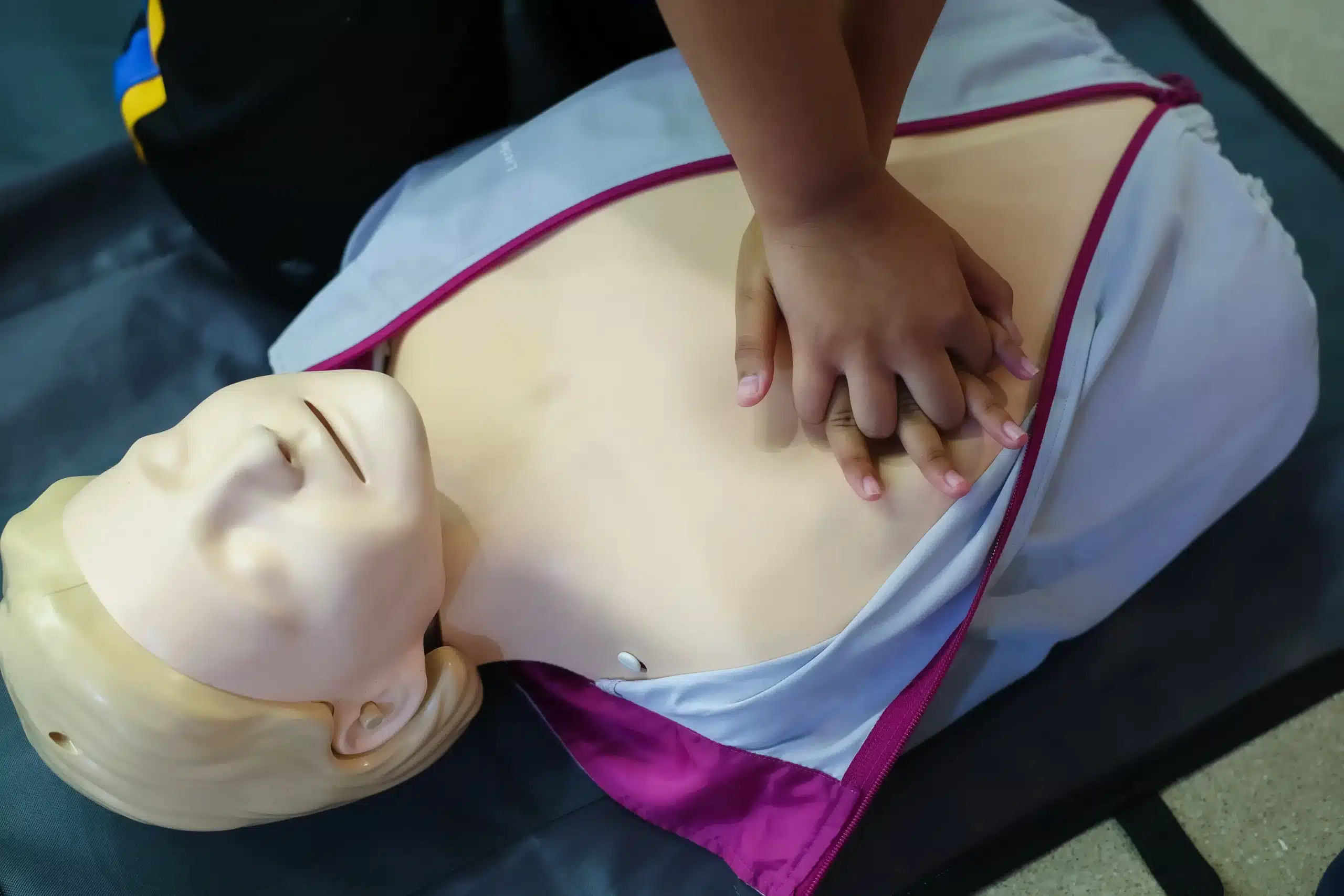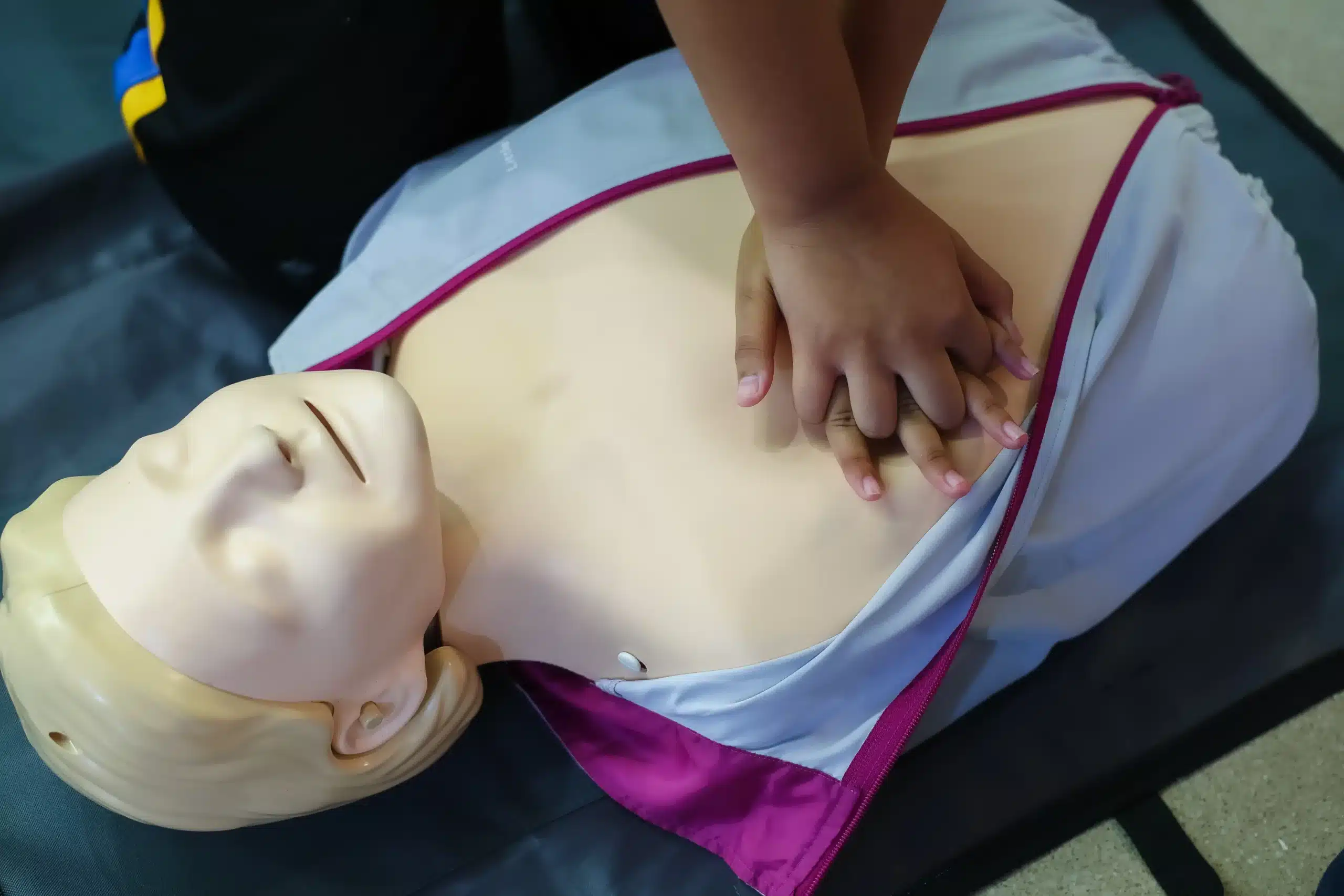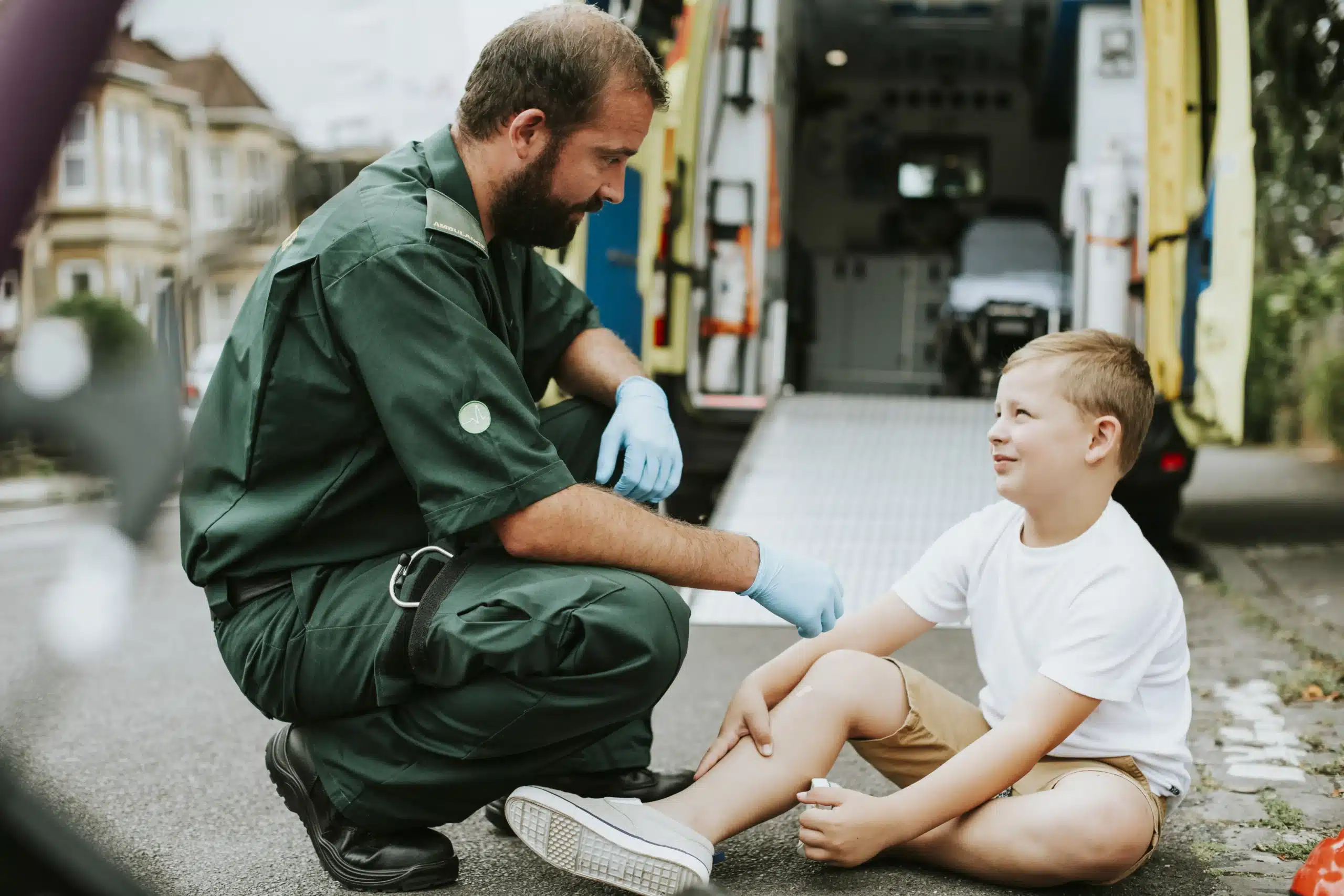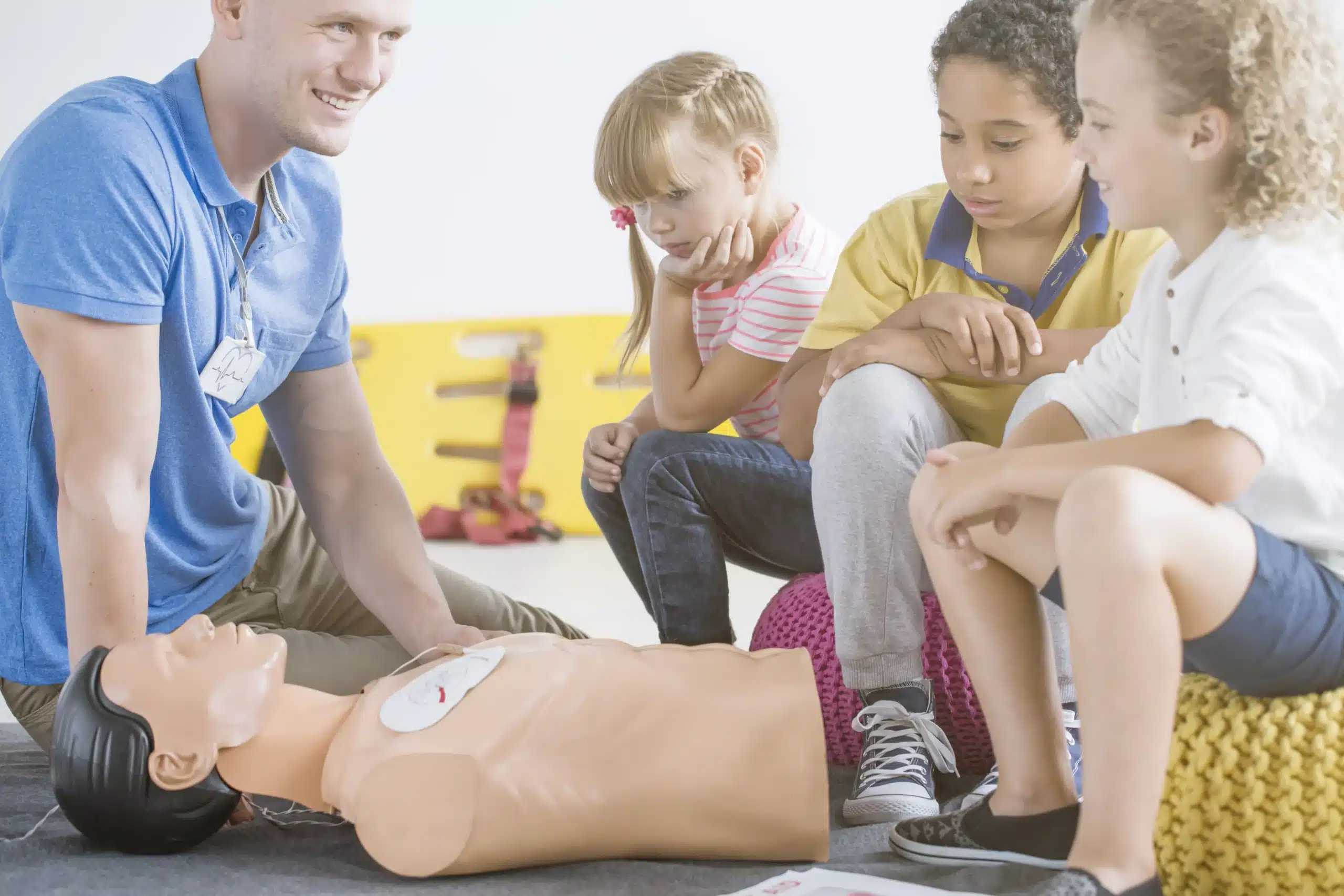Want to learn how to save a life? Basic Life Support (BLS) training gives you the power to respond effectively in medical emergencies. This guide simplifies everything you need to know about BLS, from its core components to finding BLS classes near me. We’ll cover who needs BLS certification, the different types of training available, and what to expect during a BLS course. We’ll also explore the costs and career benefits of BLS certification and provide tips for preparing for your class and maintaining your skills afterward. Ready to become a confident first responder? Let’s get started.
Key Takeaways
- BLS certification provides essential life-saving skills. Whether you’re a healthcare professional or want to be prepared for emergencies, BLS training equips you with the knowledge and skills to respond effectively. Explore different learning formats to find the best fit.
- Select a reputable BLS training provider. AHA-approved courses with experienced instructors ensure high-quality training. Consider factors like location, schedule, and reviews when making your choice. Safety Training Seminars offers convenient and affordable options.
- Stay current with BLS skills through ongoing practice. Utilize resources like practice apps, refresher courses, and updated AHA guidelines to maintain your skills and confidence in emergency situations.
What is BLS?
Basic Life Support (BLS) is a more advanced level of training than CPR, designed for healthcare professionals and first responders like doctors, nurses, EMTs, and paramedics. BLS certification covers the essentials of CPR but also includes additional techniques for managing cardiac arrest, respiratory distress, and airway obstructions. It emphasizes early recognition and intervention, incorporating AED use and high-quality chest compressions. The goal of BLS is to provide immediate care and stabilize a patient until more advanced medical help arrives.
What BLS is and why it matters
BLS training equips individuals with the skills to respond effectively in critical situations, potentially saving lives. It goes beyond basic CPR by incorporating a team approach, emphasizing coordinated efforts during emergencies. Widespread BLS education improves bystander response rates, a crucial factor in positive outcomes for out-of-hospital cardiac arrests (learn more about BLS training and outcomes00700-5/fulltext)). These skills are vital for professionals and anyone who wants to be prepared to help in a medical emergency. Even those outside the medical field, such as students and community members, can benefit from BLS training, gaining confidence and competence in providing essential life-saving care (research on BLS training for undergraduates). Having more people trained in BLS creates a safer environment for everyone.
Who needs BLS certification?
BLS certification is geared toward healthcare providers and aspiring instructors (BLS certification information). Many healthcare employers, including hospitals and clinics, require certifications approved by organizations like the American Heart Association (AHA) (choosing the right BLS certification). This ensures their staff have the most up-to-date knowledge and skills in life support techniques. While BLS certification is often a job requirement in healthcare, it’s a valuable asset for anyone working in roles with potential exposure to medical emergencies, such as teachers, coaches, and security personnel. Even if not required, BLS certification demonstrates a commitment to safety and preparedness.
Find BLS Classes Near You
Finding the right BLS class depends on your learning style, schedule, and preferences. Let’s explore the different training formats available.
In-Person BLS Classes
In-person BLS classes provide a structured learning environment with direct interaction with instructors and other students. This format is ideal for those who value hands-on learning and thrive in a classroom setting. These classes offer real-time feedback, allowing you to practice your skills and ask questions. Research shows that in-person training is vital for improving outcomes for out-of-hospital cardiac arrest because it increases bystander response Engaging Culturally Diverse Groups in Basic Life Support (BLS)00700-5/fulltext). The hands-on practice you gain in in-person training is essential for building the muscle memory and confidence needed to perform CPR and use an AED effectively. If you learn best by doing and prefer personal interaction, in-person classes might be your best bet.
Online BLS Courses
Online BLS courses offer flexibility and convenience, making them a good option for those with busy schedules or limited access to in-person training locations. You can learn at your own pace and revisit materials as needed. This format can be particularly helpful for those who prefer to study independently. However, it’s important to remember that while online courses offer theoretical knowledge, the American Heart Association (AHA) requires an in-person skills assessment component for certification (Is the online bls at American Heart Association hard to pass?). So, if your workplace requires AHA certification, ensure any online course you choose includes this crucial practical element. Look for courses that offer a blended learning approach or provide information on how to schedule your skills assessment.
Blended Learning
Blended learning combines the flexibility of online learning with the hands-on practice of in-person training. This format allows you to complete the theoretical coursework online at your convenience, then schedule a shorter in-person session to demonstrate your skills and receive your certification. The Red Cross highlights the increasing popularity of this approach (BLS Certification, Renewal & Training in Georgia | Red Cross), which offers a practical solution for those balancing work, family, and other commitments. Blended learning offers a good balance for those who appreciate the convenience of online learning but also recognize the importance of hands-on practice.
Choose the Right BLS Provider
So you’re ready to sign up for Basic Life Support training—great! Choosing the right provider is an important step. Here’s what to look for:
Accreditation and AHA Approval
First things first: make absolutely sure the course is accredited and approved by the American Heart Association (AHA). AHA approval is non-negotiable for most employers, so double-check the course materials. Look for that AHA stamp of approval before you commit. It’s the gold standard in BLS training and ensures your certification will be widely recognized. Our courses at Safety Training Seminars meet these requirements, so you can rest assured your BLS certification will be valid and respected.
Instructor Expertise
Think about it: you’re learning life-saving skills. You want someone experienced at the helm. Look for BLS providers with certified instructors who have a strong background. Real-world experience makes a huge difference. Seasoned instructors can offer practical insights and answer your questions in a way that textbooks just can’t. At Safety Training Seminars, our instructors bring years of experience to the classroom, providing you with the best possible learning environment. We encourage you to explore our discount group class options.
Course Reviews and Reputation
Before you sign up, do a little digging. Check online reviews and see what other students have to say. Focus on comments about the quality of instruction and the hands-on training. Getting a feel for the course’s effectiveness and the instructor’s reputation is key. We’re proud of the positive feedback we receive at Safety Training Seminars, and we encourage you to explore our website and see what our students are saying. You can also check out our low price guarantee for added peace of mind.
What Happens in BLS Training?
BLS training blends theory, hands-on practice, and realistic scenarios to prepare you for real-life emergencies. Here’s a glimpse into what you can expect:
Theory
First, you’ll dive into the fundamentals of Basic Life Support. This covers essential concepts like recognizing the signs of a cardiac arrest, understanding the importance of immediate intervention, and learning the chain of survival. High-quality BLS training emphasizes the significance of bystander response in improving outcomes for out-of-hospital cardiac arrest. You’ll learn how to assess the scene, ensure safety, and activate the emergency response system. This part of the training also covers the physiological aspects of cardiac arrest and how BLS techniques address these. It’s designed to give you a solid theoretical foundation before you move on to practical application. You can explore more about the impact of bystander intervention and community involvement in BLS training00700-5/fulltext).
Hands-on Practice
Theory is important, but hands-on practice is where you truly develop your BLS skills. You’ll work with training manikins to practice chest compressions, giving rescue breaths, and using an AED (automated external defibrillator). Effective feedback is crucial for skill development, and research shows that continuous feedback from a manikin, along with instructor guidance, significantly improves technique. This means your training will likely involve practicing on manikins equipped with feedback technology, allowing you to refine your compressions and ventilation skills in real-time. A study00716-7/pdf) published in Resuscitation Journal highlighted the importance of this type of feedback in optimizing BLS performance. At Safety Training Seminars, our instructors prioritize hands-on training to build your confidence and competence. Check out our discount group classes for a cost-effective way to learn with others.
Scenarios and Feedback
BLS training isn’t just about memorizing steps; it’s about applying those steps in dynamic, real-world situations. Scenario-based training immerses you in simulated emergencies, requiring you to assess the situation, make quick decisions, and perform BLS under pressure. This approach helps you develop critical thinking skills and adapt your knowledge to different circumstances. Furthermore, receiving objective feedback during these scenarios is essential for improvement. Studies have shown that real-time feedback, combined with post-scenario debriefing using tools like video recordings, significantly enhances BLS skills and boosts trainee confidence. You can learn more about the benefits of objective feedback in BLS training. We incorporate these evidence-based feedback methods at Safety Training Seminars to ensure you receive the most effective training possible. For more information on how real-time feedback and debriefing enhance BLS skills, take a look at this research. Our commitment to providing high-quality training is backed by our low price guarantee, so you can get the best BLS education without breaking the bank.
Get BLS Certified
Getting your BLS certification is straightforward. Here’s what you need to know about course details, testing, and keeping your certification current. At Safety Training Seminars, we offer BLS certification courses in Petaluma, convenient to Rohnert Park and Novato as well.
Course Details and Duration
BLS certification courses equip healthcare providers and aspiring instructors with the skills to respond to life-threatening emergencies. You’ll find BLS training in various formats, including in-person classes and blended learning (online and in-person components). BLS certification is typically valid for two years. Check with your provider for specifics. We offer a variety of course schedules at Safety Training Seminars to accommodate busy schedules.
Skills Testing
The American Heart Association (AHA) sets the standard for BLS certification, requiring both an online component and an in-person skills assessment. This means there aren’t fully online options for AHA-certified BLS training. The in-person assessment ensures you can demonstrate your skills in a realistic environment. Our instructors at Safety Training Seminars will guide you through the process and ensure you’re prepared.
Certification Renewal
Both CPR and BLS certifications are valid for two years. To maintain your credentials, you’ll need to recertify. Most providers, including Safety Training Seminars, offer recertification courses. If your certification recently expired (within 30 days), you might still be eligible to recertify. Check with your certifying organization or training provider for their specific policies. We make recertification easy at Safety Training Seminars, so you can stay current with the latest life-saving techniques.
BLS Class Costs and Value
Pricing and Discounts
BLS class costs vary based on the training provider, location, and course format. You can expect to find BLS certification courses around $75, which typically covers CPR for adults, children, and infants, AED use, and the seven steps of CPR. For the most up-to-date pricing in your area, always check directly with your chosen provider, like Safety Training Seminars. Many providers offer discounts for group bookings, so if you’re training with colleagues or friends, explore those options. Check our group discount page for more information on discounts for group classes. Also, keep an eye out for promotions on training materials—you might find deals like free shipping on essential supplies. Safety Training Seminars offers a low price guarantee, ensuring you receive excellent value for your training.
Career Benefits
BLS certification is a powerful addition to your resume, particularly in healthcare and related fields requiring emergency response skills. Many employers require AHA-approved BLS certification, so confirm this accreditation when selecting a course. This certification demonstrates your preparedness to handle critical situations and your commitment to patient safety. BLS certification goes beyond standard CPR training, equipping you with advanced techniques for cardiac arrest, respiratory distress, and airway obstructions. These skills make you a valuable asset in any medical or emergency response environment. Earning your BLS certification from Safety Training Seminars provides the credentials you need for career advancement. We offer various American Heart Association certifications, including ACLS and PALS, to further enhance your qualifications.
Prepare for Your BLS Class
Getting ready for your BLS class isn’t just about showing up—a little prep work can make a big difference in how much you get out of the experience. Knowing what to expect and how to prepare can help you feel confident and ready to learn.
What to Bring and Pre-Course Prep
Before your BLS class, take a look at any pre-course materials provided by your instructor or training center. This might include a student handbook or online modules. Familiarizing yourself with the basic concepts beforehand can give you a head start. A pen and notepad can also be useful for jotting down notes or questions during the course. Most importantly, come prepared with a positive attitude and a willingness to learn!
Dress Code and Physical Requirements
BLS classes are hands-on, so comfortable clothing is essential. You’ll be moving around and performing chest compressions, so choose practical attire that allows for a full range of motion. Avoid anything too restrictive. Comfortable athletic shoes are recommended. Check with your training center for any specific dress code guidelines. Being comfortable will help you focus on learning these lifesaving skills.
Improve Your BLS Skills
Once you’re BLS certified, maintaining and improving your skills is crucial for confident and effective emergency response. Here’s how to stay sharp:
AHA Guidelines and Resources
The American Heart Association (AHA) regularly updates its BLS guidelines based on the latest scientific evidence. Staying informed about these updates ensures you’re practicing the most effective techniques. The AHA provides various resources, including videos and manuals, to help you stay current. These resources are valuable for everyone, especially for reaching diverse communities and improving bystander response to out-of-hospital cardiac arrests. Engaging diverse groups00700-5/fulltext) in BLS education is vital for better outcomes.
Practice Apps and Tests
Consistent practice is key to retaining BLS skills. Several apps offer interactive simulations and quizzes to reinforce your knowledge and technique. Regular practice, combined with objective feedback, significantly improves performance both immediately after training and weeks later. Consider supplementing instructor feedback with feedback from training manikins for more effective learning. This extra layer of feedback can make a real difference in skill retention.
Refresher Courses and Skill Maintenance
Even with regular practice, taking a BLS refresher course is a good idea. Refresher courses reinforce core concepts and introduce any updated guidelines. Studies show that incorporating reflective practice after your initial training improves recall and reduces the time it takes to initiate BLS in real-world scenarios. This type of practice also boosts your confidence in your abilities.
Peer Learning and Support
Learning and practicing with peers creates a supportive environment for improving your skills. Consider joining a study group or practicing scenarios with colleagues. Peer learning reinforces your own skills and provides valuable insights from others. Real-time feedback and post-training debriefings with peers, even using video recordings, can significantly enhance your BLS performance.
Locate BLS Classes Near You
Finding the right BLS class is easier than you think. Whether you prefer online searches or checking with local providers, several convenient options are available.
Online Search Tools
Start your search using online tools like Google, Bing, or even dedicated CPR class finders. Refine your search by including your city and state—for example, “BLS classes Petaluma CA”—or even your zip code. Many search engines allow you to filter by “near me,” showing the closest options. Look for courses that clearly state they offer AHA-approved BLS certification, as this is often a requirement for healthcare jobs.
Local BLS Training Providers
Beyond online searches, consider these local resources:
Safety Training Seminars
For those in or near Petaluma, Rohnert Park, and Novato, Safety Training Seminars offers convenient and affordable in-person AHA BLS classes. Hands-on training is crucial for building the muscle memory you’ll need in a real emergency. Check out their low price guarantee and group discounts.
American Red Cross
The American Red Cross is another well-known provider of BLS certification courses. They offer a range of options, often including both in-person and blended learning formats (a combination of online and in-person training).
American Heart Association
While the AHA doesn’t directly teach classes, they set the standards for BLS training. You can often find local training centers listed on the AHA website. Make sure any course you choose is AHA-approved to ensure it meets these rigorous standards.
Hospitals and Healthcare Facilities
Many hospitals and healthcare facilities offer BLS training programs to their staff and sometimes to the public. Check with your local hospitals or clinics to see if they offer classes. These programs are often a good choice because they are deeply integrated into real-world healthcare settings.
Colleges and Universities
Colleges and universities, particularly those with nursing or allied health programs, may offer BLS certification courses. These can be a good option for students or community members seeking high-quality training.
More BLS Resources
After your initial BLS certification, continued learning is key to maintaining your skills and staying up-to-date with the latest guidelines. Here are some resources to help you refresh your knowledge:
Online Refresher Courses
Online refresher courses offer a convenient way to brush up on your BLS skills. Many courses use interactive elements like videos and quizzes to reinforce key concepts. Some programs even incorporate simulations with feedback on your technique, similar to having a personal instructor. This type of continuous feedback has been shown to significantly improve both chest compression and ventilation techniques, leading to better outcomes. Find an online refresher course00716-7/pdf) that fits your schedule and learning style.
Practice Apps
Think of practice apps as your pocket-sized BLS coach. These apps provide interactive exercises, simulations, and quizzes to help you master essential skills. Many apps also incorporate reflective practice, encouraging you to think critically about your performance and identify areas for improvement. Studies have shown that even short reflective practice sessions after standard BLS training can lead to better performance and increased confidence.
Guideline Access
Staying current with the latest American Heart Association guidelines is crucial for providing effective BLS. Easy access to these guidelines00700-5/fulltext) ensures you’re always prepared to deliver the highest quality care. Regularly reviewing updated resources and incorporating new techniques into your practice will help you maintain a high standard of BLS performance. Widespread BLS education and readily available resources are vital for increasing bystander response and improving outcomes for out-of-hospital cardiac arrests.
Related Articles
- Complete Guide to Basic Life Support (BLS) in Rohnert Park
- BLS Renewal in Novato: Your Complete Guide – Petaluma CPR Classes
- HeartCode BLS in Rohnert Park: Your Certification Guide – Petaluma CPR Classes
- BLS Renewal in Petaluma: Your Easy Guide – Petaluma CPR Classes
- BLS Courses in Rohnert Park: Your Complete Guide – Petaluma CPR Classes
Frequently Asked Questions
What’s the difference between CPR and BLS? CPR is a basic life-saving technique that anyone can learn. BLS builds upon CPR, adding advanced skills for healthcare professionals and first responders. Think of BLS as CPR plus extra tools and knowledge for medical emergencies.
How do I choose the right BLS class format? Consider your learning style and schedule. In-person classes offer hands-on practice and direct interaction with instructors. Online courses provide flexibility, but remember that AHA certification requires an in-person skills test. Blended learning combines online coursework with in-person skills sessions.
Why is AHA certification important for BLS? Most healthcare employers require AHA-approved BLS certification. It’s the gold standard, ensuring your training meets the latest evidence-based guidelines and is recognized nationwide.
How can I stay up-to-date on my BLS skills after getting certified? Regular practice is key. Use online resources, practice apps, and consider refresher courses. Staying informed about updated AHA guidelines will also help you maintain your skills and provide the best possible care.
What if my BLS certification is close to expiring or has recently expired? Contact your certifying organization or training provider about recertification options. You might still be eligible to recertify even if your card is slightly expired. Many providers offer streamlined recertification courses to get you back on track quickly.
